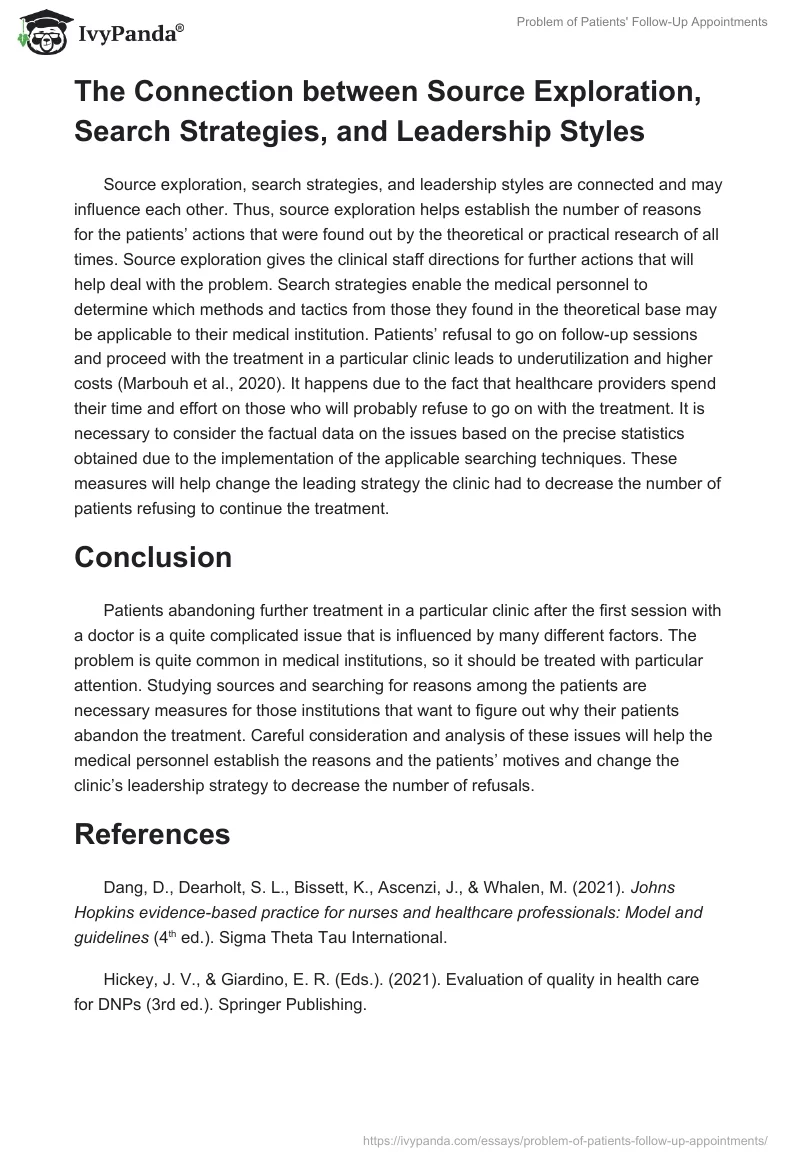Introduction
When dealing with a problem in any field, it is essential to develop certain search strategies that will help solve it from a short- and long-term perspective. When speaking about the problems concerning the healthcare system, it is necessary to state that many of them severely damage the quality of medical services (Dang et al., 2021). That is why leaders need to search for possible ways of solving these problems in order not to let the quality of the services decrease. The problem of patients abandoning follow-up appointments requires special consideration as well as special solving techniques.
Learning Resources & Search Strategies That Work for the Problem
When looking for scientific data to determine the frequency of the problem, it is possible to see that the issue of patients not returning to hospitals for follow-up sessions is quite spread. Since the reasons for such decisions may concern many different factors – from the patient’s discontent with the services to their poor financial state, it is the leaders’ duty to deal with the problem. The most common tool that helps establish the reason for the patients’ abandoning the follow-ups in hospitals is qualitative research, which helps the medical personnel to see the motives for the patients’ actions (Ofei-Dodoo et al., 2019). The majority of the sources on the topic used this method as it helps the clinical staff establish the reasons for the patients’ decisions and suggests areas for further improvement (Hickey & Giardino, 2021). Hence, when searching for strategies that will help deal with the problem, it is necessary to consider methods that will point out the patients’ motives and possible solutions for the medical institutions.
The Connection between Source Exploration, Search Strategies, and Leadership Styles
Source exploration, search strategies, and leadership styles are connected and may influence each other. Thus, source exploration helps establish the number of reasons for the patients’ actions that were found out by the theoretical or practical research of all times. Source exploration gives the clinical staff directions for further actions that will help deal with the problem. Search strategies enable the medical personnel to determine which methods and tactics from those they found in the theoretical base may be applicable to their medical institution. Patients’ refusal to go on follow-up sessions and proceed with the treatment in a particular clinic leads to underutilization and higher costs (Marbouh et al., 2020). It happens due to the fact that healthcare providers spend their time and effort on those who will probably refuse to go on with the treatment. It is necessary to consider the factual data on the issues based on the precise statistics obtained due to the implementation of the applicable searching techniques. These measures will help change the leading strategy the clinic had to decrease the number of patients refusing to continue the treatment.
Conclusion
Patients abandoning further treatment in a particular clinic after the first session with a doctor is a quite complicated issue that is influenced by many different factors. The problem is quite common in medical institutions, so it should be treated with particular attention. Studying sources and searching for reasons among the patients are necessary measures for those institutions that want to figure out why their patients abandon the treatment. Careful consideration and analysis of these issues will help the medical personnel establish the reasons and the patients’ motives and change the clinic’s leadership strategy to decrease the number of refusals.
References
Dang, D., Dearholt, S. L., Bissett, K., Ascenzi, J., & Whalen, M. (2021). Johns Hopkins evidence-based practice for nurses and healthcare professionals: Model and guidelines (4th ed.). Sigma Theta Tau International.
Hickey, J. V., & Giardino, E. R. (Eds.). (2021). Evaluation of quality in health care for DNPs (3rd ed.). Springer Publishing.
Marbouh, D., Khaleel, I., Al Shanquiti, K., Al Tamimi, M., Simsekler, M. C. E., Ellahham, S., Alibazoglu, D. & Alibazoglu, H. (2020). Evaluating the impact of patient no-shows on service quality. Risk Management and Healthcare Policy, 13, 509-517.
Ofei-Dodoo, S., Kellerman, R., Hartpence, C., Mills, K., & Manlove, E. (2019). Why patients miss scheduled outpatient appointments at urban academic residency clinics: A qualitative evaluation. Kansas Journal of Medicine, 12(3), 57. Web.


